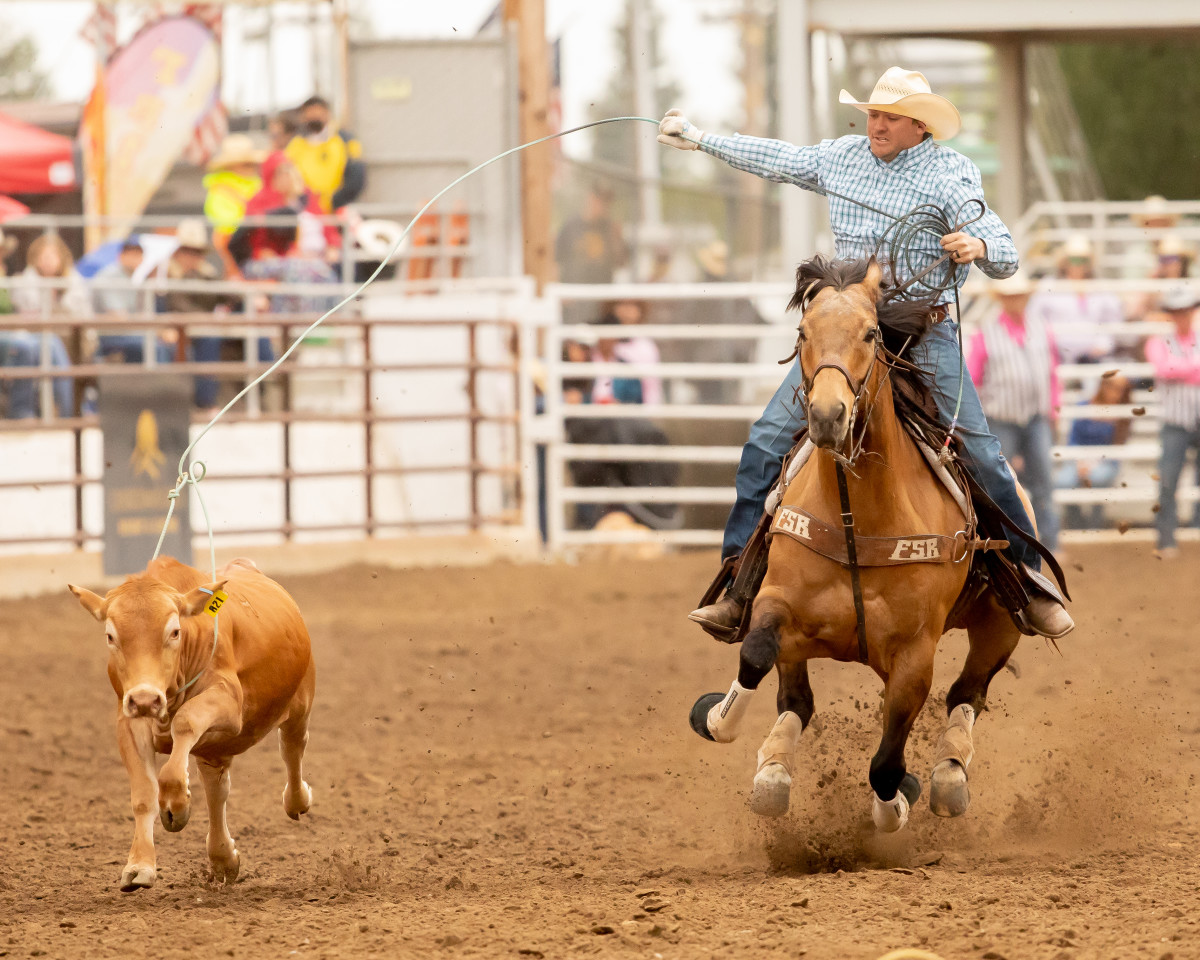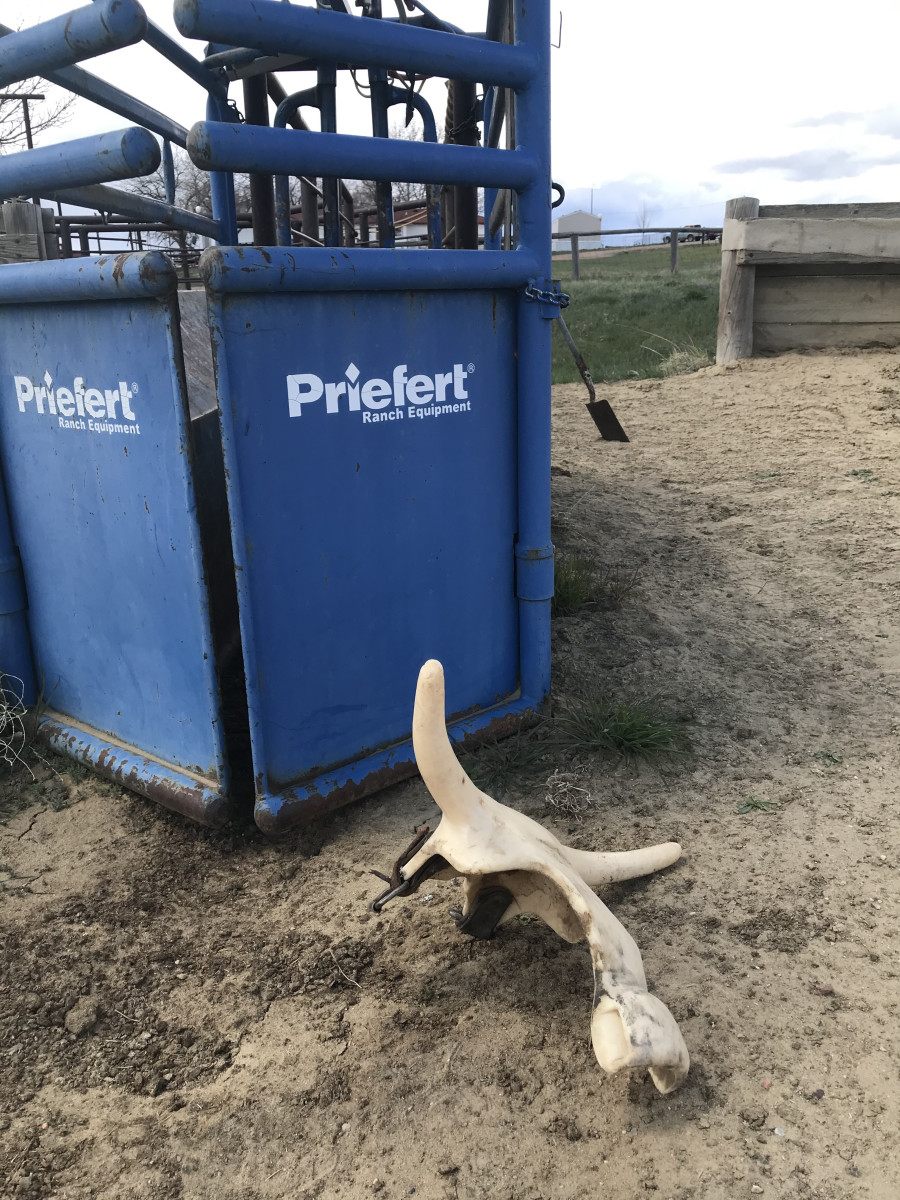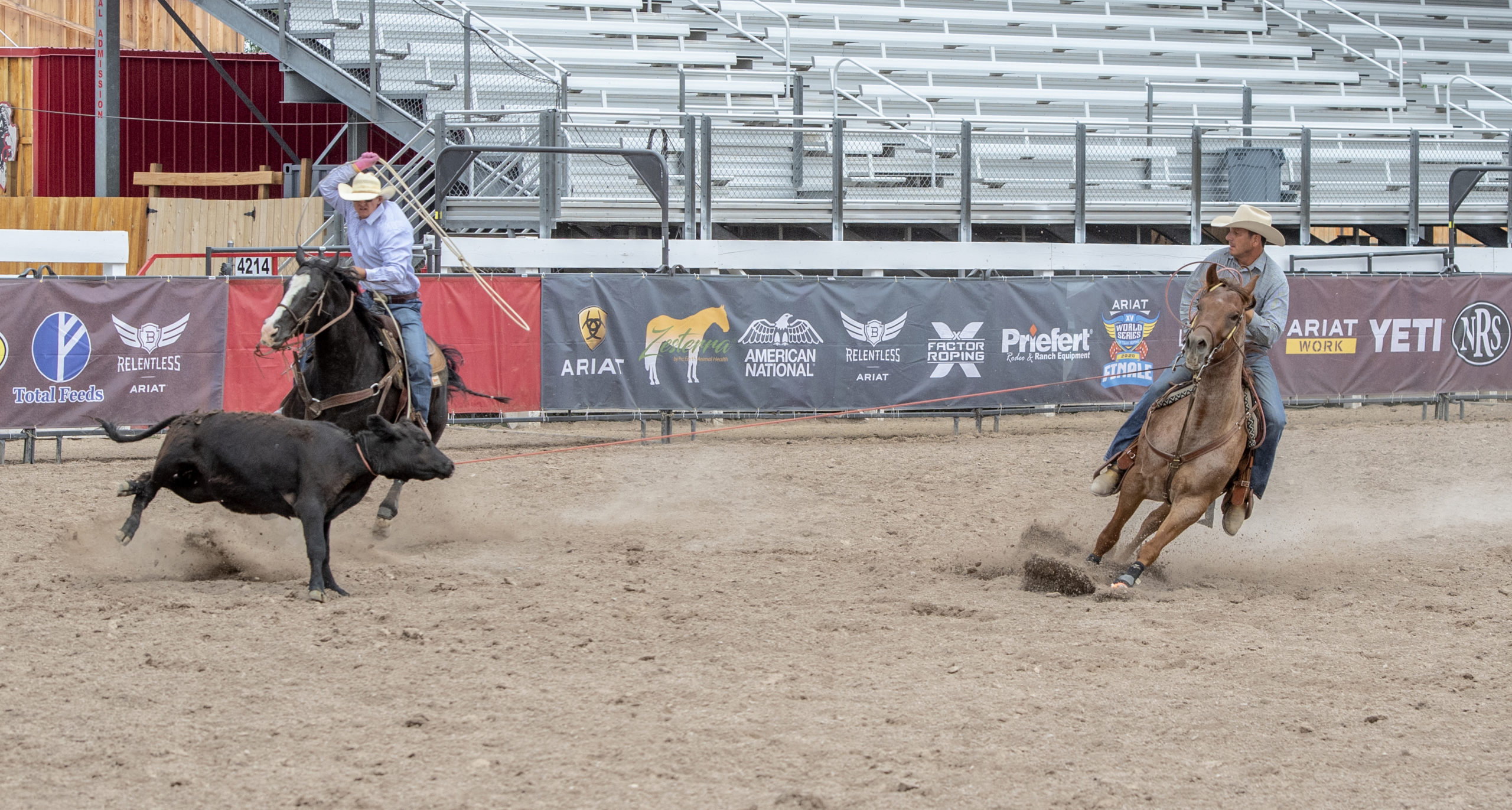Catching a totally untamed animal that’s never worn a rope is exactly what spawned the first Cheyenne Frontier Days in 1897. A handful of local bronc busters were coaxing wild horses into a railroad car and had to get super handy when one broke away. Their talents drew a crowd and gave the watching Union Pacific executive the idea for the Wyoming festival celebrating frontier cowboys—in its 125th year this July.
It’s no surprise that when the Daddy of ’em All—known for its fresh stock and giant head start—finally added team roping 20 years ago, it was on beef cattle. Heck, the handiest ropers have always practiced on “muleys.” Northerners spent many a winter 30 years ago crowding indoor barns to strap plastic horns on them.
But just lately, more producers are contracting hornless yearlings despite their intimidating, old-school vibe. So what do you need to know about roping muleys? We canvassed producers, horse trainers and champions for the 4-1-1.

Gaining Speed
South Dakota’s Levi Lord wouldn’t mind seeing “the Daddy” go back to using muleys instead of former tripping steers, because every team could start with a fresh one and not so many cows would go left, he said. PRCA director Matt Sherwood, too, is a fan of muleys and helped approve the use of yearling beef cattle at Clovis (California) Rodeo for the first time this spring. He likes them for several reasons: They add an element of difficulty that delights fans, they draw huge entries that beef up the purse, and they’re flat-out fun to rope.
“Literally everybody back behind the bucking chutes, from bronc riders to bull riders, was up on the chutes to watch the team roping at Clovis,” said arena director Vince Genco. “It’s not a chuck-and-duck deal—you’ve got to ride up on those cattle and handle them. I still don’t know how some of those heelers catch those cattle.”
America watched Tyler Wade and Trey Yates capture arguably the fastest cow on the planet this spring at the televised Clovis Rodeo to win $6,822 a man while, just a week later, Nelson Wyatt snuck up on three head at Guymon (Oklahoma) Pioneer Days for Lord to hammer them and earn $3,416 a man. Plus, this month, Johnnie Johnson will bring back his popular Muley Slide ropings to The Daddy WSTR contest in Cheyenne. Last year, the #12.5 and #13.5 muley ropings paid the champs $8,120 and $6,320, respectively.
Wade, who grew up breaking in steers with neck catches, likes to practice on muleys at home. In his opinion, you can stick with perfect horned steers that run medium speed with their heads up—or you can get better.
Saving Dollars
The beauty of practicing on muleys is that they rarely develop the same tricks as Longhorns or Corrientes. You’ll hardly ever see one drag or duck its head. But most agree that the biggest benefit is the price savings.
In 2020, John Growney’s steer contractor lost untold dollars on the 300 head of horned steers he bought for Clovis that were never used. Faced with the same pandemic-related uncertainty this year, Genco decided to go with some good Mexican beef cattle that were already grazing nearby. Nobody would get stuck financially. Not only that, but in the end Genco figures the muleys saved them $20 a run during the rodeo.
Whereas it costs roughly $700 to buy a Corriente or native and you’re lucky to sell it later for $250, you can actually make money on hornless cattle, says longtime muley roper Rory Brown of Edgemont, South Dakota. That’s the reason he first started roping his own replacement heifers decades ago.
Brown, an 8-roper and rancher who’s been making head and heel horses for as long as he’s been making the Badlands Circuit Finals Rodeo—about 40 years—says muleys are good for colts. And while yearlings do sometimes get heavy, they never pull on a head horse as badly as does a horned dragger. What’s more? They’re usually very even.
“I’ve seen really good horned steers and some really bad horned steers in most bunches of cattle, but I’ve used lots of sets of muleys and they’re nearly all the same,” said Brown, the 2014 Badlands Circuit champion heeler.
He’s currently practicing but not dallying on 10 yearlings he got from a neighbor for free in March, in return for feeding them until fall. They’ll be good all summer, he said. And muleys’ reputation for being supersonic is not accurate, in his opinion.
“They still only run half as fast as a fresh Longhorn or Corriente because they’re shorter-legged, so they don’t cover as much country,” he said. “People get intimidated because they look like they’re really trying hard and maybe even bellowing, but they’re not getting down the arena that fast.”

Breaking in Muleys
So what are the drawbacks? For one, beef cattle have a penchant for handling badly. Cheyenne Frontier Days quit featuring the wild, unpredictable beasts because some 16 hind legs were broken that first year in slack alone. But according to Brown, they can be roped safely if they’re simply broken in right.
“They need to be handled very delicately when you’re breaking them in, and you have to take your time,” he said. “I put the rope on in the chute and never let them get going very fast because I’m dallied in the box. They feel it once they barely get out of a trot. I run them through that way at least three times.”
Brown also makes sure they’re slightly sedated with acepromazine those first three times. He entered the Big Daddy muley ropings last summer and noted that JX2 Productions didn’t hurt a single muley. They’d obviously been broken in. Plus, he noted, they were Jersey-cross bred.
Jerseys don’t get going as fast because they don’t have as much heart, Brown said. He added that some Longhorn crosses are okay to rope as muleys, along with Angus. He bought Herefords once long ago, he said, and they were no good. Gary Rodarmel brings the muleys for Johnson to Cheyenne, broke in just enough to take it. There have been no injuries whatsoever.
“And what a cool deal, to win a muley roping in ol’ Cheyenne,” said Johnson, whose The Daddy returns July 22–26 to the Laramie County Community College facility after a one-time stint last year at Frontier Park. “Gary brings outstanding cattle, so I tip my hat to him and to Peter Farner, whose idea it was to have muley ropings.”
This July, Johnson requested enough muleys to run two arenas. That’s because those ropings have been drawing some 200 teams, he said.
“I’ve tried having muley ropings out East, and they haven’t caught on—except at the NTRL Finals in Jacksonville,” he said. “There, it’s gotten so big that this winter I had a truck dealer ask to become the main sponsor.”
Muleys aren’t just popular with the guys. Texan Anna Gregory once dominated a muley roping. She later told Johnson that his muley ropings pay so well, she’d asked her husband to buy her a couple of muleys for Christmas and she’d practiced all year for that roping. What’s more? That same week, the smaller end of the The Daddy muleys will provide premium breakaway cattle.
The Perfect Catch
Despite the popularity of Johnson’s muley ropings, he swears he personally can’t catch a neck. He’s not alone. Good horn ropers are often intimidated by the different technique a neck catch requires.
“Your tip’s got to be down enough to go over their nose, but not so low that your curl snags a front leg,” said Wade, who was a tie-down roper in high school. “It’s kind of tricky. I try to make sure my bottom strand hits the back of their head so my curl comes around across the left shoulder, like if you roped from behind them. The angle of your loop has to be right.”
There’s an art to heading calves. The first year Cheyenne roped muleys, Blair Burk won the team roping with Preston Williams. But even if you’ve never breakaway roped or tied down a calf, don’t dismiss the idea of mastering neck-catching, especially if you want your practice cattle staying good.
“A neck catch keeps cows leading by the rope, while a horn catch can become a total tug-of-war because they can sit on the end of it,” said Wade. “When you have pressure on their neck, they want that release.”
He points out that everyone needs to practice different scenarios, not just the pros.
“Knowing how to catch the neck makes you a better roper,” Wade said. “Practice on a tougher set of cows. I rope the cuts from our jackpots that duck their head or come left or whatever, because being able to adjust makes you better.”
In Clovis, Wade used a Classic Powerline Lite in a softer lay than usual for more tip control. In Guymon, Lord was using a Cactus Future in medium-hard instead of hard-medium.
Regarding the handle, Lord actually likes his header to go left with muleys because he feels like they handle better (it helps that he likes super-fast handles). Lord thinks if the cow is waiting and dangling on the end of the rope, it’s more likely to get wild and go down. It worked in Guymon, anyway.
Heeling Fresh Muleys and Winning the Guymon Pioneer Days Rodeo with Levi Lord
“I don’t know if there’s a perfect way to do it, because it can work out or not work out, either way,” he said.
Left-circling cows are no fun, so Wade rides wide when heading muleys to keep them straight. And Lord waits and lets his header leave first on a fresh muley. He’ll even let one step to the right. But that doesn’t mean he’s lagging behind.
“On fresh muleys, a heeler has to ride a little more defensive position,” he added. “You can hang out there more on an older steer, but on a muley you’d better be paying attention. I try to see them hit out in front of me and then heel, because they’re not very predictable. I also ride farther away and ride farther through the turn, just to make sure the cow’s going away from me and not hanging on the end of it. But the main thing is to just ride more defensive.”
On both ends, on fresh muleys, the ability read a cow in real time is huge. Wade said it’s the key to turning a muley fast and keeping it on its feet—not to mention helping your heeler know where the feet are going to be. Of course, “sometimes you just have to cowboy up,” he added.
Spoken like a true stockman from the frontier days.











